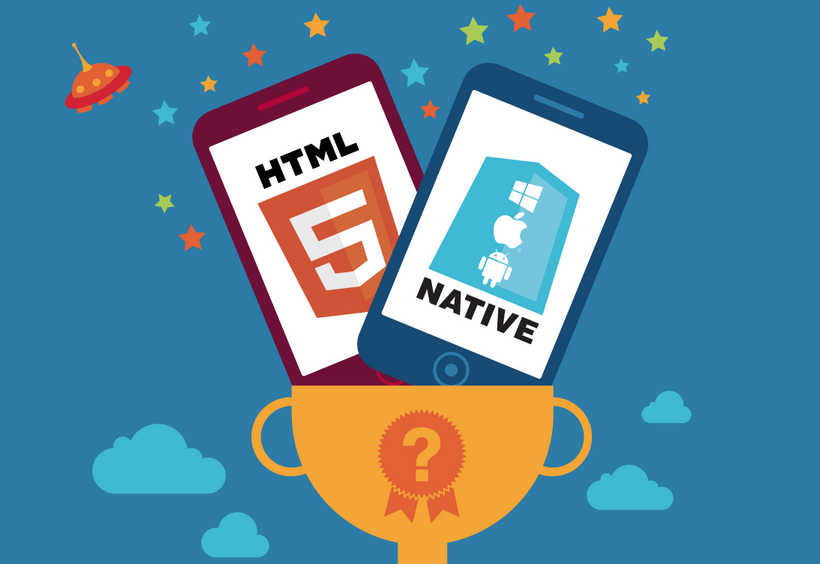App-venture Time
As a general rule, every business goes online according to the following scenario — the company opens up a website which is then adapted for mobile devices, and if an increase in traffic is observed, the company finds it worthwhile to secure its position among mobile device owners and releases an app.
Comparing a mobile website and an app seems redundant, as an app is obviously superior with its broader range of features and a responsive interface that is much more comfortable to use on a phone or a tablet. Moreover, an app can be used offline.
Regardless of what your business is primarily focused on — sales, services or education — you simply can’t afford to ignore the amount of time people spend with their mobile gadgets.
This article is aimed to shed light on two distinct approaches in app development — native and
Both approaches have their own specifics that greatly influence the end product. To help the customer and the developer understand each other better, it seems like a good idea to elaborate on both approaches, highlight their pros
and cons, strike at the
Native approach
The apps you encounter on the first day of using your device are native — they are your default browser, mail client, address book, alarm clock, calendar and other basic programs.
When the developers use a programming language that is conventional for the specific platform like
Cross-platform approach
On the other hand, imagine a mobile website that doesn’t have to be online and that is closer to mobile apps instead of web pages from a design standpoint. This is a rough outline of what
They are often created using formatting and styles (HTML, CSS and JavaScript), much like mobile websites. This is a viable approach because, after all, most Internet content consists of HTML pages. Such apps are written for all platforms simultaneously and are suitable for most devices as they use a browser engine to work.
Most specialists who deal with such apps use the PhoneGap framework, which is remarkable for granting the app access to most software and hardware capabilities of the platform.
«Live Typing» has experience in
«PhoneGap helps us build reliablecross-platform apps that run on both iOS and Android. In particular, PhoneGap helps us reduce the time it takes to build an app, which reduces costs for our clients."
Vladislav Korobov, Live Typing`s COO
Hybrid apps
Apparently, the bar to enter the immensely profitable mobile app development field has lowered significantly, so one might think that layout designers who are fine with using tried and true HTML and CSS will now take the bread away from
proper coders. Some, however, consider the
But when we look for a solution to a specific task, the most effective way is to combine both approaches by employing the
What situations may call for a hybrid approach? Let’s say the customer requires a straightforward newsfeed that contains nothing but text and images. With this task in mind, the developer is right to choose the
It is a popular fallacy that behind every icon on the user’s desktop there is a native app. This fallacy is so
Approach comparison
The market of offers is expanding. Mobile app sales statistics indicate that year after year gadget users switch default services to alternative ones. The
It’s essential for the customer to know the pros and cons of both approaches and don’t have unreasonably high expectations when making their choice. A range of criteria would be appropriate for a comparative analysis of both approaches.
Platform dependency
It may look as if a
Interface design
When talking about mobile apps, mentioning guidelines is inevitable. Guidelines are valuable instructions that the companies that create platforms provide for mobile app developers to help them fit their design and features into the platform design standards. Guidelines are the psychological foundation of the user’s comfort — simply put, they ensure that the interface elements look familiar and are conveniently arranged.
The language environment in which native apps are developed contains the tools necessary to create an interface that would be familiar to the user. Web technology, however, is different — making a
User experience
The first thing the user subconsciously expects from an app is responsiveness. Each of the user’s action must elicit a response, page scrolling and animation has to be smooth and nothing should freeze up.
The user is also convinced that every interface element and icon is supposed to have a consistent look and position on the app’s screen. These standards vary on different platforms, and if a
The Back button is one of the most vivid examples — it’s a typical Android feature which has no iOS counterpart. As a result, when creating a
Limitations
A native app written for a specific platform feels completely at home in it, enjoying full access to the device’s services and features. But when designing a
Frameworks are also liable to have a whole range of versions and the older the version, the more limitations it imposes. Even in the best scenario a
Security
HTTPS exists as the standard secure data transfer protocol for all popular browsers. But if a higher level of encryption is required, the developer is expected to come up with a solution. The trick is that reliable data security can only be guaranteed with native development, as security requires extensive calculations, and thus requires maximum efficiency of hardware usage.
Maintenance and support
Complex maintenance of native apps for two platforms at once (troubleshooting, updates and literally every single small patch) on average takes twice as much resources because two different specialists (iOS and Android) are required.
A
Price formation for mobile app development and time spent on it is a topic mired in fallacies and myths, which is why these issues should be brought up separately in an attempt to set matters straight or at least try to clear things up somewhat.
Is quick and cheap
cross-platform development a myth or a reality?
Always keep in mind that timescales and prices are, first and foremost, governed by the difficulty of the task and the end quality of the solution. Let’s say that to develop our
Two such units are required for native app development — for iOS and Android. As a result, 2 man months are required for the native project, and 1.5 — for the
A fair question is in order: «Why one and a half instead of one»? Sadly, in reality a
Here is an estimate of mobile app development cost in case of both native and
| Platform | AVG Freelancer, $ | Man months | Hours | Total, $ |
| iOS/Android | 25 | 2 | 320 | 8000 |
| Hybrid app | 25 | 1,5 | 240 | 6000 |
When we were comparing the approaches according to several criteria, we mentioned that the degree of platform integration of the app is determined by the difficulty of the task the app solves. Be aware
that using a specific template or a
But there’s a catch
And the catch is in the app’s structural specifics. More often than not a functioning app implies that there’s a server side where the users save their data and using which they exchange their data with others. This leads to further expenses. Working on the server side may take up to one third of development time and even more if an admin panel has to be created for convenient data management.
Summary
By all means, go for native development if:
- Your application requires full access to the phone’s resources and services;
- You want your app to be as responsive as possible;
- The app has to work offline;
- Your app should have maximum efficiency when using the device’s hardware.
- You can live with lower responsiveness;
- You do not intend your app to contain complex animation or carry out calculations;
- Your app requires stable Internet connection to download content;
- You need to enter the market quickly to test your idea;
- You have a website and you want to turn it into an app for a minimal price.
The final choice of your strategy is determined by individual circumstances, something for which no article can give you a universally applicable answer.
This text is more of an






